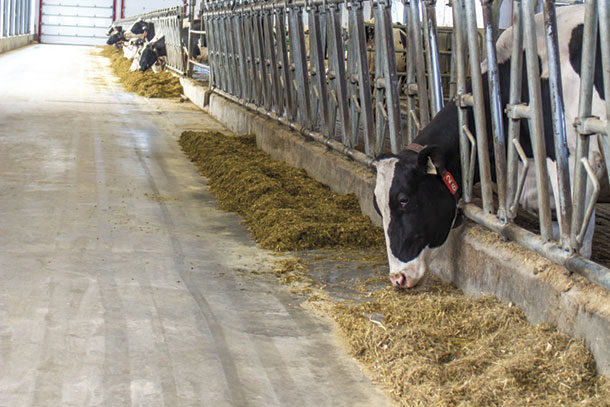Feeding a prepartum ration with a negative dietary cation-anion difference (DCAD) minimizes the risk of both clinical and subclinical hypocalcemia.
An acidogenic diet, or a negative DCAD diet, influences the acid-base status of the animal by inducing compensated metabolic acidosis and lowering blood pH. This decrease in blood pH improves responsiveness to hormonal signaling, increasing calcium resorption from bone, and activates vitamin D, increasing efficiency of calcium absorption from the rumen and small intestine.
Clinical hypocalcemia, or milk fever, on well-managed dairy farms impacts less than 2% of fresh cows on large operations. Subclinical hypocalcemia (SCH) is a much more prevalent problem, impacting approximately 50% of fresh cows. Low milk production, poor reproductive efficiency, impaired energy balance and susceptibility to periparturient diseases are directly related to SCH. This costly problem is best managed through full acidification of prepartum diets to a urine pH range of 5.5 to 6.0. When cows move in and out of this urine pH range on an almost daily or diurnal basis, this is known as “yo-yoing” in and out of compensated metabolic acidosis.
Several feed management factors can lead to the yo-yo effect:
- Forage changes or improper chop length for hay or straw may change the composition of the TMR and allow sorting.
- Overcrowding reduces intake through limited feedbunk space or access to water.
- Frequent pen moves cause social stress, leading to reduced intake.
Thus, the success of fully acidogenic prepartum diets depends on the ability to deliver the formulated TMR at accurately predicted levels of DCAD and dry matter intake (DMI).
Recent in-depth inquiries by our field-based account managers uncovered unintentional mistakes made on farms when mixing the rations for close-up cows. The resulting changes in the composition of feed or the resulting decrease of DMI altered the acid-base status of the cows and increased their susceptibility to SCH at parturition. The mistakes included:
- Mixing errors
- Residual feed was left in the mixer from previous lactation rations.
- Ingredient amounts were weighed inaccurately.
- TMR batch size was below the range for consistent mixing for the equipment.
- Amount of feed presented each day differed from the formulated ration.
- Ingredient errors
- Untested high DCAD forages were used instead of known low DCAD ones.
- The wrong amount of DCAD product/mineral mix was used.
- Positive DCAD lactation mineral was used instead of the negative DCAD prefresh mineral.
These mistakes resulted in a wide variation of urine pH from day to day. The “yo-yoing” in and out of the target urine pH range ultimately led to higher case numbers of SCH and related transition cow problems. An in-field investigation period of more than two weeks uncovered these mistakes and prevented blame from falling on the nutritional consultants, the dairy employees that fed the close-up cows or individual feed ingredients. It also prevented further manipulation of the diet to fix a problem that did not originate from the formulation of the ration.
A similar evaluation performed previously on six farms feeding TMRs formulated for a DCAD of -10 to -20 mEq per 100 grams dry matter (DM) uncovered issues in the close-up pen when urine pH target was not met consistently. All farms used an identical commercial anionic product as the single source of anions. Urine pH was targeted at 5.5 to 6.0 and was systematically collected between the hours of 0400 to 2000 for three days from random multiparous cows. Feeding times and available bunk space were recorded and measured. Information on herd data is shown in Table 1, while urine pH ranges are shown in Figure 1.


Analysis of each prepartum diet revealed all six farms delivered a TMR with a resulting DCAD from -10 to -16 mEq per 100 grams DM as planned, yet not all achieved the desired urine pH results.
Half of the farms (3, 5 & 6) had average urine pH values within the 5.5 to 6.0 range for each of the time windows throughout the day, although Farms 5 and 6 were slightly higher in the early mornings before feeding time. These data agree with findings from 2007 that urine pH can be monitored at any time of day when anionic salts are used to achieve a target pH of 5.5 to 6.0.
Early each day, Farm 1 was above the range before the morning feed delivery. The evaluation found this was due to three reasons: Feedbunks were being cleaned too soon before feed delivery, feed was delivered later than planned, or not enough feed was offered to make it through the night.
The account managers also found that despite feeding a TMR with the same DCAD analysis, Farms 2 and 4 were unable to achieve a urine pH of 5.5 to 6.0. The DCAD value is only a formulation number, and urine pH should be the final determining factor of the cows’ response to the negative DCAD diet. Facilities or equipment were the limiting factors for this lack of response.
Urine pH on Farm 2 averaged 7.2 with higher variation and only had 15.2 inches of bunk space per cow. Overcrowding bunk space limits DMI by causing changes in meal pattern behavior or increasing sorting of a TMR fed once daily, limiting the effectiveness of the acidogenic diet. Overcrowding is a common reason why DCAD rations fail.
Urine pH at Farm 4 averaged 6.9 with a large amount of variation as well. In this case, there was plenty of bunk space per cow, so overcrowding was not the issue. The Penn State Particle Separator helped to reveal excessive sorting due to poorly chopped straw which ranged from 1 to 6 inches of particle length. This resulted in urine pH samples ranging from 5.5 to 8.5 or a “yo-yo” effect from cow to cow and from day to day within cows. Particle size of straw or hay for TMRs should not exceed 2 inches in length, and DM should be targeted to around 50% to prevent sorting. This is another reason why DCAD rations can fail.
Variation in urine pH can indicate challenges such as overcrowding or TMR sorting. When urine pH samples range from 5.5 to 8.0, investigations of all factors to improve TMR consistency and minimize sorting should be the focus of management. Improvement in feeding management could minimize variation in performance, improve start-up milk and increase the overall benefits of feeding a negative DCAD ration in the prepartum period.
Avoiding the “yo-yo effect” of moving in and out of the urine pH target range can pay big dividends. Ask your nutritionist or feed supplier for help determining why this is occurring. If allowed to work, fully acidogenic diets can help improve postpartum DMI, reduce SCH and increase start-up milk production.











